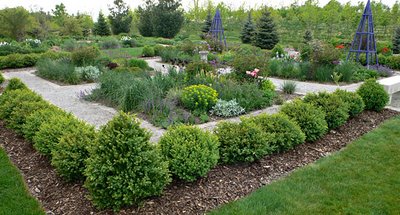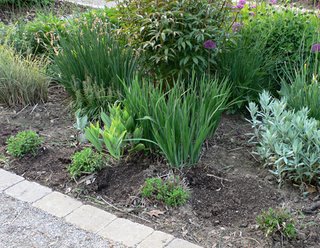When we first moved to our country property eight years ago this month, the place had been rented out for years, and what wasn't a rough hayfield was a tangle of burdocks, buckthorn, poison ivy, thistles and rusted farm detritus.
That first season, aside from growing a few tomatoes and annuals in what passed for a front yard, we didn't garden: we just cleaned up big time. Bulldozers were involved.

In our second spring here, we laid out a four-square garden divided up by paths, which began as vegetable garden with wood-chips for the paths. The garden turned out to be too big for vegetables - there are just two of us to eat them - and so I planted it full of bulbs and perennials.
A couple of years later, we added compacted stone chip paths edged with pavers, and the next season planted boxwood around the edging beds, which we might (or might not) train into a proper hedge one day. The picture above was taken the year we planted the boxwoods. Looks neat as pin, doesn't it?
And now only seven years after planting, the four-square garden is having a mid-life crisis. I noticed last season that my laissez-faire style of gardening – minimal deadheading, allowing self-seeding – had resulted in a lot of thugs taking over.

The worst of the lot have been Verbena bonariensis (Brazilian verbena), Knautia macedonica and drumstick alliums, (which look like grasses in the picture, above).
I still love all these plants, just not the pushy way they take over if they're not deadheaded.
Lesson learned: although this is a country garden, deadheading isn't out - it's going to be IN this year big-time.
A couple of days ago, we tackled the many overgrown masses of drumstick alliums in the four-square, and dug in and pulled them all out. They were mostly lined up near the front of the beds between clumps of lavender (last spring's replacements for an edging of unruly catmint, which I'd pulled out the year before).

Now, the lavender can breathe and grow, and the garden is starting to regain shape and a measure of grace.
Until now, much of our gardening here has been filling the space with plants. We have planted scores of trees and shrubs, and hundreds of perennials (many of those grown from seed when we were first starting out and needed masses of plants cheaply).
A part of me is taken aback that radical editing is necessary so soon, but I shouldn't be surprised at all:
plants grow. Gardening once you've got something going is actually the process of controlling growth. A good gardener edits - a lot.
All of this has me reaching for my well-annotated copy of the book
Growing Pains by Patricia Thorpe, which I intend to re-read immediately. It appears to be out of print, but you can find copies on Amazon.com for a song.
Here's are a couple of samples from the book:
"Remember those early days when you carefully set out three of each perennial in the border? How did those three suddenly become fifty?"
"There is the disconcerting sense that the garden, something we once thought of as our creation, is evolving in unexpected ways, growing beyond some of our aspirations while coming up woefully short with respect to others. … We may notice definite changes in our gardens before they reach the end of their first decade. For some gardens it will be a seven-year-itch. Others may be faster or slower to mature to this dangerous stage."
If you're in the same boat and need help, I highly recommend this book. There's plenty of solid advice and best of all, Thorpe gives you permission to rip out those daisies or irises or alliums or overgrown shrubs that are giving you headaches.
My gardening motto for the seven-year-itch: more control, less chaos. The trouble is this all translates into a four-letter word: WORK!











